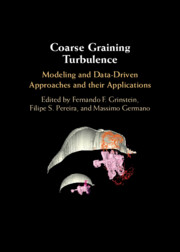Book contents
- Frontmatter
- Contents
- Contributors
- Prologue
- Part I Paradigms and Tools
- 1 Numerical Simulations and Coarse-Graining
- 2 An Overview of Scale-Resolving Simulation Models for Practical Flows
- 3 Filtering Approaches and Coarse Graining
- 4 Filtered Density Function
- 5 Symmetries, Subgrid-Scale Modeling, and Coarse Graining
- 6 Coarse-Graining Turbulence Using the Mori–Zwanzig Formalism
- 7 Data-Driven Modeling for Coarse Graining
- 8 Verification, Validation, Uncertainty Quantification, and Coarse-Graining
- Part II Challenges
- Epilogue
- Abbreviations
- Index
- References
3 - Filtering Approaches and Coarse Graining
from Part I - Paradigms and Tools
Published online by Cambridge University Press: 31 January 2025
- Frontmatter
- Contents
- Contributors
- Prologue
- Part I Paradigms and Tools
- 1 Numerical Simulations and Coarse-Graining
- 2 An Overview of Scale-Resolving Simulation Models for Practical Flows
- 3 Filtering Approaches and Coarse Graining
- 4 Filtered Density Function
- 5 Symmetries, Subgrid-Scale Modeling, and Coarse Graining
- 6 Coarse-Graining Turbulence Using the Mori–Zwanzig Formalism
- 7 Data-Driven Modeling for Coarse Graining
- 8 Verification, Validation, Uncertainty Quantification, and Coarse-Graining
- Part II Challenges
- Epilogue
- Abbreviations
- Index
- References
Summary
The filtering approach is a simple deterministic way to formalize analytically coarse-grained representations of a given turbulent flow. By their own nature, turbulence and coarse graining (CG) are multiscaled, and in this chapter, we discuss the specific question of the relations between turbulence, coarse graining, and filtering in a unified operational form, with particular interest to multiscale properties and aspects. Reynolds averaged Navier–Stokes (RANS) averaging, explicit convolutional large eddy simulation (LES) filtering formulations (Leonard, 1975), implicit LES and scale resolving simulations (SRS) approaches (Grinstein et al., 2010; Grinstein, 2016; Pereira et al., 2021), functional and structural LES modeling procedures (Sagaut, 2006) and hybrid RANS/LES methods (Fr¨ohlich and von Terzi, 2008), are revisited and discussed from the point of view of a multiscale operational filtering approach (OFA) (Germano, 1992) based on the multiscale properties of the generalized central moments (GCM). Some recent results are presented both as regards analysis, modeling, and post-processing of turbulent flows, and finally, some conclusions and some personal recalls are provided.
- Type
- Chapter
- Information
- Coarse Graining TurbulenceModeling and Data-Driven Approaches and their Applications, pp. 91 - 126Publisher: Cambridge University PressPrint publication year: 2025

